Slovenia: Istra region
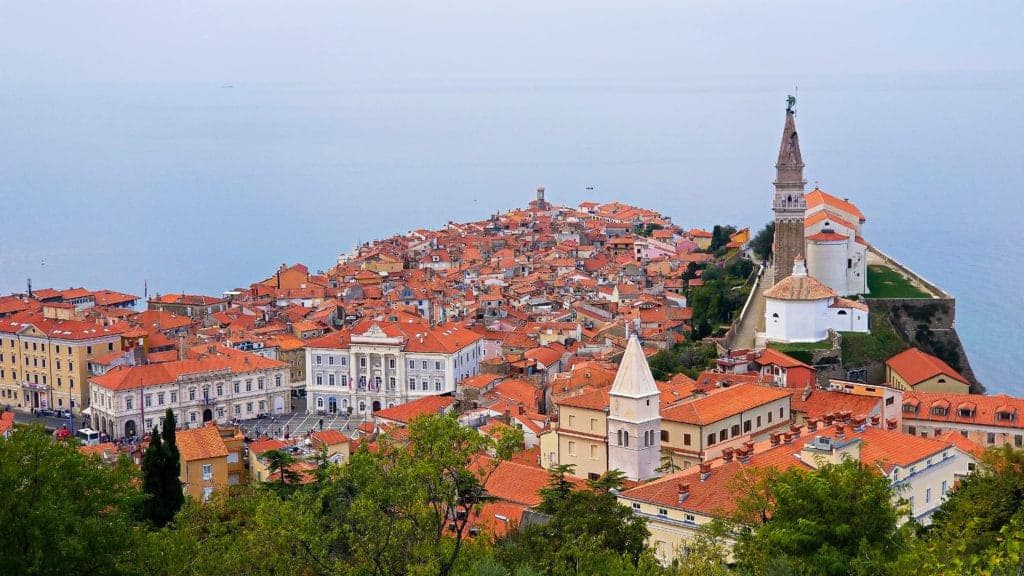
Mike and I have just left Slovenia after a 51-day visit. Just as a reminder, Slovenia is less than ½ the size of Nova Scotia, and for our American friends, it is smaller than the state of New Jersey with a population of about 2 million which is equivalent to New Mexico. We have just spent the last 12 days in Koper which is on Slovenia’s 47 km (29 mi) coastline on the Gulf of Trieste which is in the Adriatic Sea. It was an excellent spot to explore both the Trieste region and the coastal region of Slovenia.
I can see why the Istrian Peninsula on the Adriatic is such a favourite tourist destination. We biked and drove around the area and had a great time. We visited towns with history back to the BC era. The area is quite hilly, not really mountainous but with high hills. We spent a couple of days visiting the town of Piran. It is known as the major tourist destination on Slovenia’s coastline. Quite honestly, both Mike and I thought that Koper, where we stayed, was equal to or even nicer than Piran. That isn’t to downplay Piran, it is lovely. At one time Piran was a walled city and it sits right out on a small point of land. The photo at the top is of Piran. Most of the walls are now gone but a few sections remain. Piran is supposed to be one of the loveliest towns anywhere along the Adriatic Coast. It has a lot of Venetian architecture, coloured houses and winding alleys throughout the Old Town. Like most of this part of Slovenia it has a very interesting history. At different points in time it has been part of the Roman Empire, the Venetian Republic, Austria-Hungary, the Free Territory of Trieste, Italy, Yugoslavia and today is part of Slovenia. One of the items that made Piran into such a major town in the olden days was salt. For many years salt, throughout the world, was worth more than gold.
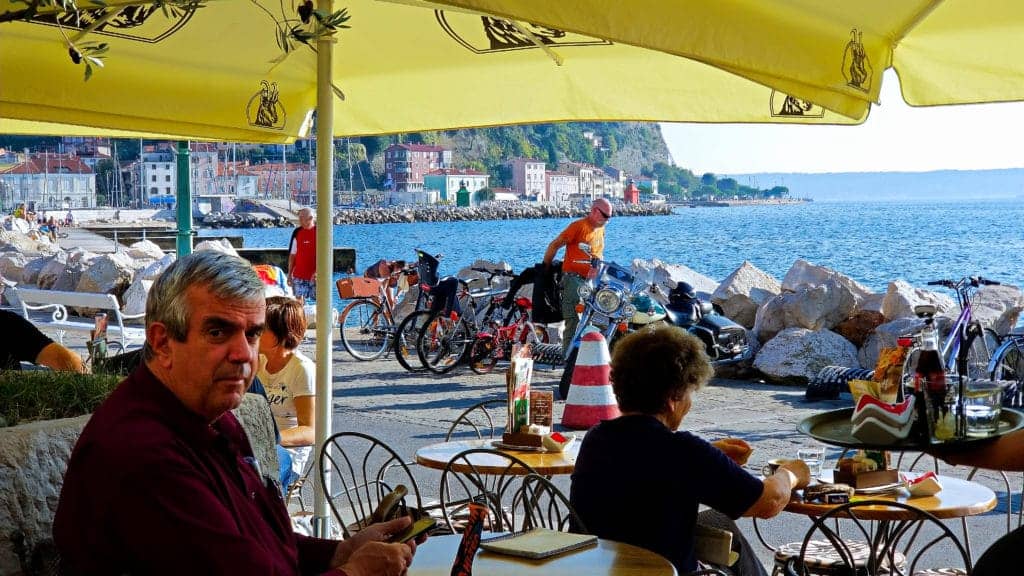
What is now the Slovenian coast line was huge into salt-pans with Piran being the epicentre. Understanding the history of salt locally gives you a good understanding of the history of the area. The first records of the Piran salt-pans are in the early 800s. In 933, when this coastal area was part of the Venetian Republic, they made it compulsory that all salt was sold to the government. This brought a lot of money into Venice. The Venetians actually destroyed many of the salt-pans in the Mediterranean to strengthen the value of their monopoly in Piran. This led to them also investing in Piran. There follows a 300 years long golden age of Piran salt-pans. In 1797 the Venetian Republic went to ruin, and the Istrian salt-pans are taken over by the Austrian administration. Twenty years later the Austro-Hungarian monarchy proclaims salt a state monopoly. In the early 1900s, after the fall of the Austro-Hungarian monarchy, the Piran salt-pans are taken over by the Italians. They had been falling into ruin and Italy reconstructed many of them. In the mid 1900s Piran becomes part of the Free Territory of Trieste and the salt-pans do very well for a short while. 20 years later many of the individual salt fields are abandoned. In the past workers had to actually move right into houses (huts) on the water in the salt fields for the summer season. Salt is still produced today but the glory days of salt have long gone. Tourism has taken over as the major industry and I read that there are mobs of people in Old Town Piran during the summer months. Mike and I are very pleased that we are visiting this area in early October. The weather has been great and while there are quite a few people around, you don’t have the summer crowds at all.
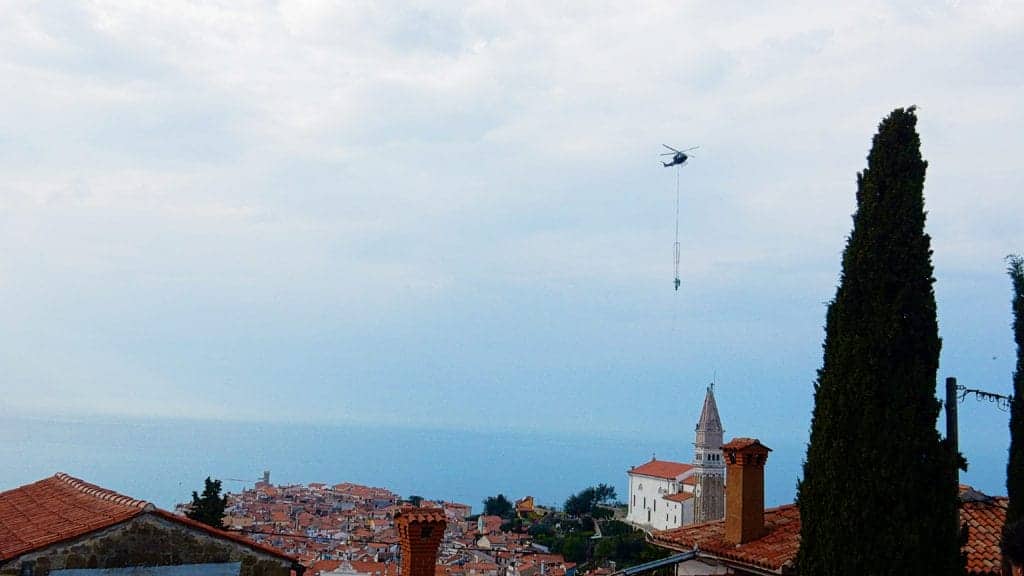
On our last visit to Piran we saw a crowd gathering on a hill overlooking the town. Of course, we had to join them. We spent half an hour watching a helicopter pick up a huge bronze angel statue from the waterfront and take it up to the landmark church on the hill. It then hovered well above the church and its spire and lowered the angel down onto the top of the spire above the bell tower. There were three men cabled to the spire trying to help with the angel’s landing and positioning. The helicopter did a great job of getting the angel to the correct place and then hovering for ages. It was quite fascinating to watch. The photo of Piran at the top was taken just after the statue was placed on the bell tower. In the gallery is a shot of Piran taken two days earlier before the statue was lifted into place.
As I said, we stayed in Koper, which is another lovely town on the waterfront. Koper was actually one of the most important transit routes for goods heading from Asia to central Europe. It is Slovenia’s oldest and largest town on the coast and is not quite so overrun with tourists as Piran is, but we think, it is every bit as lovely.
Koper has experienced numerous layout modifications and name changes, all due to its various reigns. Koper was called Capris in Roman times, in the times of the pope Gregory I (599) Insula Capraria (“goat island”), Iustinopolis under the Byzantine Empire (between mid 6th and 8th centuries) and Caput Histriae (‘head of Istria’) by the Aquileia Patriarchs. The Venetians rendered that name into the Italian form, Capodistria. The Slovenian equivalent today is Koper. The longest reign over the city was the Venetian Republic which was in control for over 500 years.
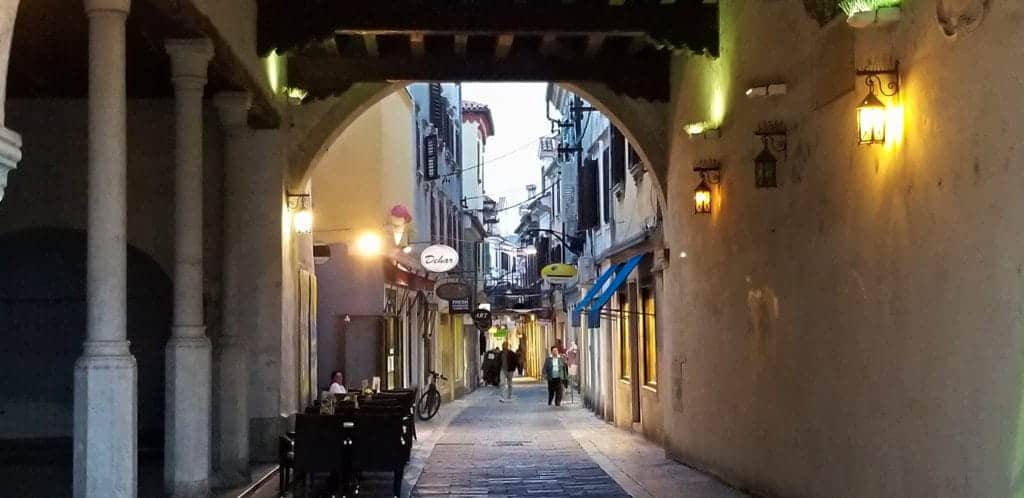
Koper’s medieval old town centers around a square with Venetian-influenced landmarks and buildings including a replica of Venice’s famed Rialto Bridge. Koper had one other huge benefit. It was the first town with a laundromat, Speed Queen no less, that we had seen since our laundry machines broke. Yeah!
Koper is especially pretty at night. The LED street lights are synchronized and slowly change colour. The actual street lamps look nice and the base of each one is surrounded by LED lights. It is an old town with some very pleasant modern touches. As in all these waterfront towns there are restaurants and cafés everywhere. In Koper the pedestrian walking areas have smoother stones with less chance for twisting your ankle than in many old towns.
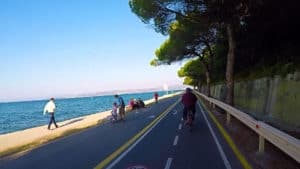
Just outside Koper, along the Adriatic a two-lane road has been changed into a road just for bikes and pedestrians. One lane is now pedestrians only. The other lane is split into two, one for bikes going in each direction. It works well and is right along the water’s edge.
One day we went for a drive in the area around Koper. I could see a small town sitting right on the top of a hill and so Mike drove us there. The town was Padna and it was actually on the top of a ridge. In some areas the ridge was just one house wide and you could stand and turn around and see two different valleys and ridge ranges. It was phenomenal. The ridges are 200 – 400 metres (650 – 1300 feet) high. In places you could look across the valley at another ridge with another small village on top of it. We drove along the ridge to Nova vas and took a picture looking across a valley to Padna. Both towns were on the same ridge that wound around the landscape. There were many valleys and ridges like this. It was lovely.
While on the ridge we saw a sight that looked quite humorous. There was a father walking his dog on a leash while the mother walked their young son also on a leash. It was an unusual picture although quite understandable given the terrain.

In this area Mike saw his first olive tree. Of course, he had to try an olive and it turns out that raw olives are extremely bitter. Since then we have seen many olive groves. Mike also saw his first persimmon tree which are very common here. There were also many vineyards with grapes and a few pomegranates.
We are leaving Slovenia after almost 2 months. We will be heading into Croatia, and we expect the area to be very similar to the Slovenian coastal area. Istria is a peninsula in the Adriatic Sea, partially owned by Italy, Slovenia and Croatia. The vast majority is part of Croatia and that is where we will be staying next. I don’t expect that today’s political boundaries will change the towns and sights very much at all.

Leave a Reply